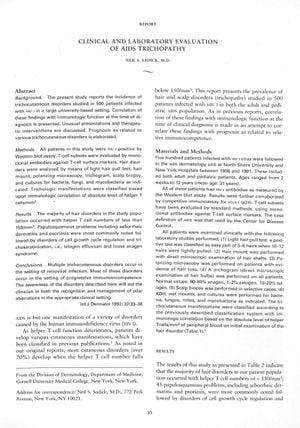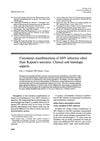CLINICAL AND LABORATORY EVALUATION OF AIDS TRICHOPATHY
January 1993
in “
International Journal of Dermatology
”
HIV helper T cell papulosquamous disorders seborrheic dermatitis psoriasis telogen effluvium loose anagen syndrome bacterial scalp conditions fungal scalp conditions infestation-related scalp conditions necrotizing folliculitis vascular hypersensitivity alopecia lymphoma premature greying acquired trichomegaly brittle hair syndrome alopecia areata vitiligo hair pull tests microscopy trichograms scalp biopsies cultures antibiotics antifungal medications topical treatments HIV T cells dandruff psoriasis hair shedding loose hair bacterial infections fungal infections lice severe folliculitis hair loss cancer grey hair long eyelashes brittle hair patchy hair loss skin discoloration hair pull test microscope hair analysis scalp biopsy lab cultures antibiotics antifungals topical creams

TLDR People with HIV and low T cell counts have more hair and scalp problems.
In a study of 500 HIV-positive patients conducted between 1986 and 1991, researchers found that hair disorders were more common in individuals with helper T cell counts below 150/mm³. The most frequent hair-related issues were papulosquamous disorders such as seborrheic dermatitis and psoriasis, followed by problems with the hair growth cycle like telogen effluvium and loose anagen syndrome. The study also reported cases of bacterial, fungal, and infestation-related scalp conditions in patients with low T cell counts. Various hair and scalp disorders, including severe necrotizing folliculitis, vascular hypersensitivity alopecia, and different types of lymphoma, were observed. Other conditions such as premature greying, acquired trichomegaly, brittle hair syndrome, alopecia areata, and vitiligo were also noted. The study concluded that a range of hair disorders are more prevalent in HIV-infected individuals as their immune system becomes compromised, and understanding these conditions can aid clinicians in managing these patients more effectively. The patient age range was 2 weeks to 72 years, with a mean age of 31 years, and diagnostic methods included hair pull tests, microscopy, trichograms, scalp biopsies, and cultures. Treatment varied depending on the specific condition and included antibiotics, antifungal medications, and topical treatments.

